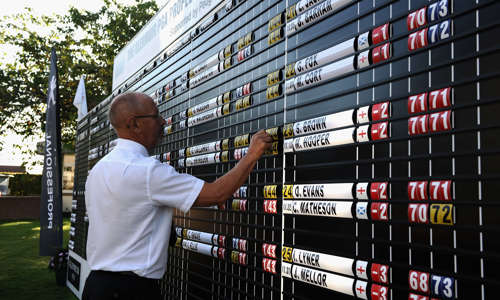Replicating the pressure of tournament play is a real challenge for coaches. Dr Karl Steptoe explores the ways in which you can help your players to practise in a way that still remains meaningful when they are under pressure out on the course.
A common aim whether you are new to the game or competing at the highest level is to experience continual development, maintain high standards and to perform when it matters most.
Fundamental to this, of course, is the attainment of sound technical skills and competencies and a requirement to replicate these movement patterns in, what is widely acknowledged as deliberate practice.
The strategy for many, however, can centre on the belief that an understanding of the golf swing, followed by repetition on the training ground, may be sufficient for successful transfer to the golf course and competition.
Like the cricketer who just wants to feel one more ball off of the centre of the bat before opening, the tennis player that demands one last serve in the warm up, or the centre forward in football that needs to hit the back of the net before kick-off, a strong emphasis is placed on proof that ‘all is well’ during preparation, in the hope that this has charged the confidence battery sufficiently to meet the psychological demands of performing under pressure. Whether observing amateur players or tour professionals alike, it is apparent that there is little correlation between warm up and competitive performance that is not at least mediated by self confidence.
Many complete their final practice session the day before a tournament, satisfied and content with the week’s preparation, only to wake up on the Thursday morning to find that confidence and trust have been replaced by doubt, uncertainty and apprehension.
Such a cycle suggests that preparation and practice serve, more than anything, to increase a player’s short-term confidence in their ability to perform leading up to competition. Ultimately, a priority is placed on feeling good with the mind again promising that “if I perform well and feel good on Monday, Tuesday and Wednesday then it will see me through Thursday to Sunday”.
The robustness of this confidence, however, does not always make it through the night, or from the practice ground to the 1st tee. Even more absurd is the fact that these rules appear to be unfalsifiable, with every unsuccessful performance leading to a doubling down of the strategy: more balls, more practice and more attempts at feeling good.
The pressure problem
The concept of pressure presents its own challenges for training design as it clearly has a level of subjectivity: what is meaningful to one player may be of little importance to another.
A commentator’s assertion, for example, that a player will be feeling pressure or experiencing any emotion for that matter, is not a statement of truth, or insight directly gained from the player’s mind, but a reflection of their own appraisal of the situation and an interpretation of observable behaviours.
Research in this space also fails to provide complete clarity, with pressure posited as “the presence of incentives that result in an appraisal that the execution of a performance calls for an optimal outcome, improved performance, or enhanced functioning” (Baumeister, 1984; Hill et al., 2011). There also exists conceptual overlap with, for example, stress which also appears to capture the golfer’s experience, and is defined as “the process that involves the perception of a substantial imbalance between environmental demands and response capability, under conditions where failure to meet demand is perceived as having important consequences it is responded to with increased levels of state anxiety” (Martens, 1977, p. 9).
“The uniqueness of a player’s inner experience when performing would seem, therefore, to leave any ‘one size fits all’ intervention purely to chance.”
The Reality of Training Design
There is no single established approach to training for pressure, (Hill et al., 2024). However, across the numerous conceptualisations in the literature is a consensus that any interventions should involve exposing players to increased levels of pressure through a purposeful manipulation of the training environment (see Kent et al., 2018; Fletcher & Arnold 2021 for review).
An example of this application can be found in preparations for the recent Team Cup between Great Britain & Ireland and Continental Europe, where players were exposed to a scoring system that placed emphasis and reward for fast starts with social forfeits for failure, simulated crowd noises and distractions on the 1st tee, a heckler that delivered a bespoke roasting of each player before their shots on a tricky par 3 and a one-minute exercise to provoke physical symptoms prior to hitting a drive on the back nine.
In these situations, reflections on efficacy often refer to how realistic the intervention has been, but to do so may miss the point.
A crowd, a scoreboard, money and a crying baby do not in isolation create pressure. As human beings we are uniquely able to relate to these ‘symbols’ through what they have come to represent and be associated with through our learning history.
Take the example of the words ‘Friday’ or ‘cut’. In response to hearing those words or even seeing them in writing, the office worker may experience feelings of relief, excitement and joy at the prospect of the upcoming weekend off.
But for a tour player, images of blood may come to mind and for some even a physical wincing response. To wish that these automatic responses would not appear is understandable but futile and attempts to control and manage them are both effortful and draining, with the potential to further negatively impact performance.
Implications for practice
- It may be that efforts to accurately replicate the external environment are a red herring and not possible – but importantly not necessary!
- There is value is exposing players to pressure through the manipulation of training demands and consequences
- It is not necessary to recreate specific and realistic aspects of the external pressure environment but instead to provoke the unique internal contexts that can be triggered by these symbols
- Coaches should involve their players in session design. Letting athletes self-define stressors (e.g., determine own forfeits) can lead to the design of more meaningful pressure manipulations and improve autonomy and buy-in
- It is important to identify what players would be DOING if the internal experience was not present, establishing these observable behaviours as the measure of success when training
- The aims of any ‘pressure training’ should be to maintain performance behaviours WITH these thoughts, feelings, emotions, memories and sensations
“The comfort sought in practice is often replaced by the discomfort with what shows up on game day. Training should instead focus on enabling the golfer to become comfortable being uncomfortable”
Anything other than the promotion of feeling good is a challenging sell. However, a growing body of research has highlighted the interpersonal and intrapersonal growth experienced by those athletes that have navigated challenges and adversity, particularly in early life. Pressure training that exposes athletes to relatively small and developmentally appropriate stressors (e.g. John et al., 2019; Sarkar & Fletcher, 2017) has gained momentum.
Such an approach requires a willingness of the player to feel a whole range of uncomfortable emotions during training and to understand how their responses in such situations are either motivated to avoid this discomfort or to maintain, for example, valuable performance standards or behaviours.
But we have become experts at feeling good with numerous strategies to dilute unwanted thoughts, feelings and emotions with the mistaken conclusion that such strategies ‘work’ because of their ability to spare you from anxiety. Under closer inspection, those same strategies, such as speeding up when nervous, or trying harder in important moments, come at the cost of a valued performance identity such as professionalism or automaticity.
Implications for PGA Professionals
The challenge for the golfer is a willingness to pass up the offer of feeling good in the short term in the service of staying connected to valued performance standards. To do so requires skills of flexibility or elasticity (Jordet, 2004) that enable the player to experience choice in how they respond to their internal environment.
Rather than the avoidance of what is uncomfortable, a player, through training, can realise their capacity to experience psychological discomfort while engaging in verbal and physical behaviours that are aligned with a valued performance identity. It requires the player to give time to what this looks like, to think not only in a future-oriented, goal-driven way but to consider how they would be playing IF it were possible to rip out all the uncomfortable stuff that shows up.
To this end, success is in the doing; the moment-to-moment engagement with the way one wants to play their golf and approach challenges. This is a level beyond process and routine and an immersion in the present moment engagement of a performance identity in the presence of uncomfortable inner experiences.
The certainty that many are seeking from quality training should, therefore, not be sought in the absence of thoughts and feelings but the ability to choose how to respond in these situations.
Click here for bibliography.



































